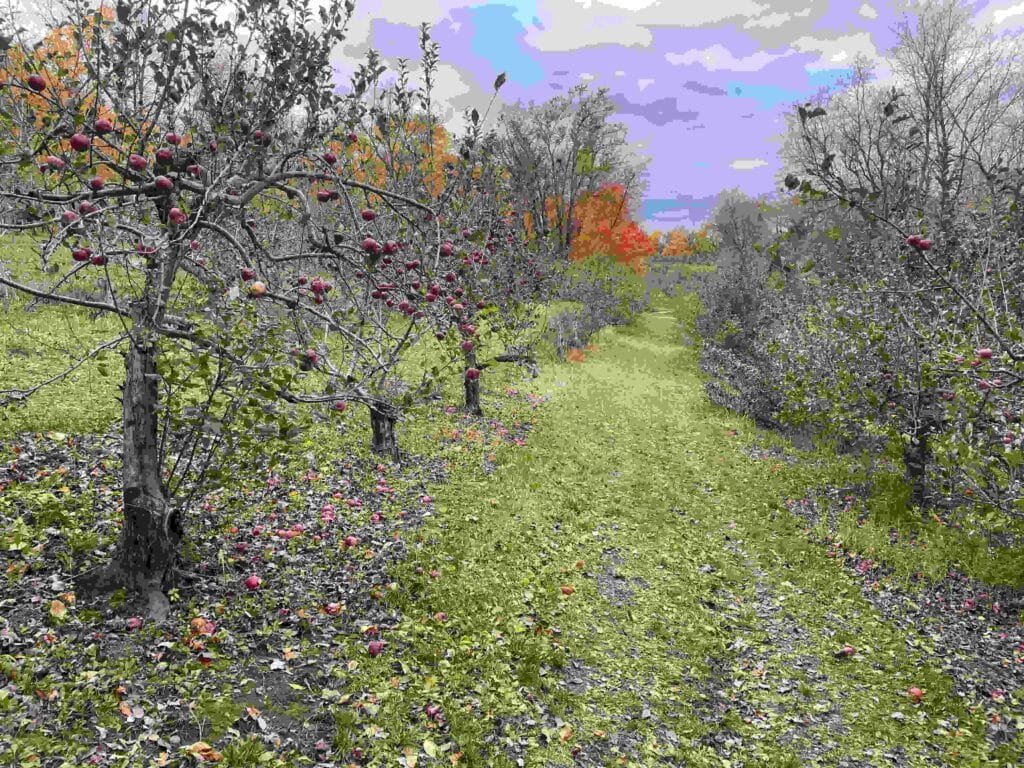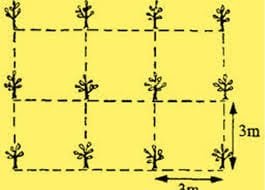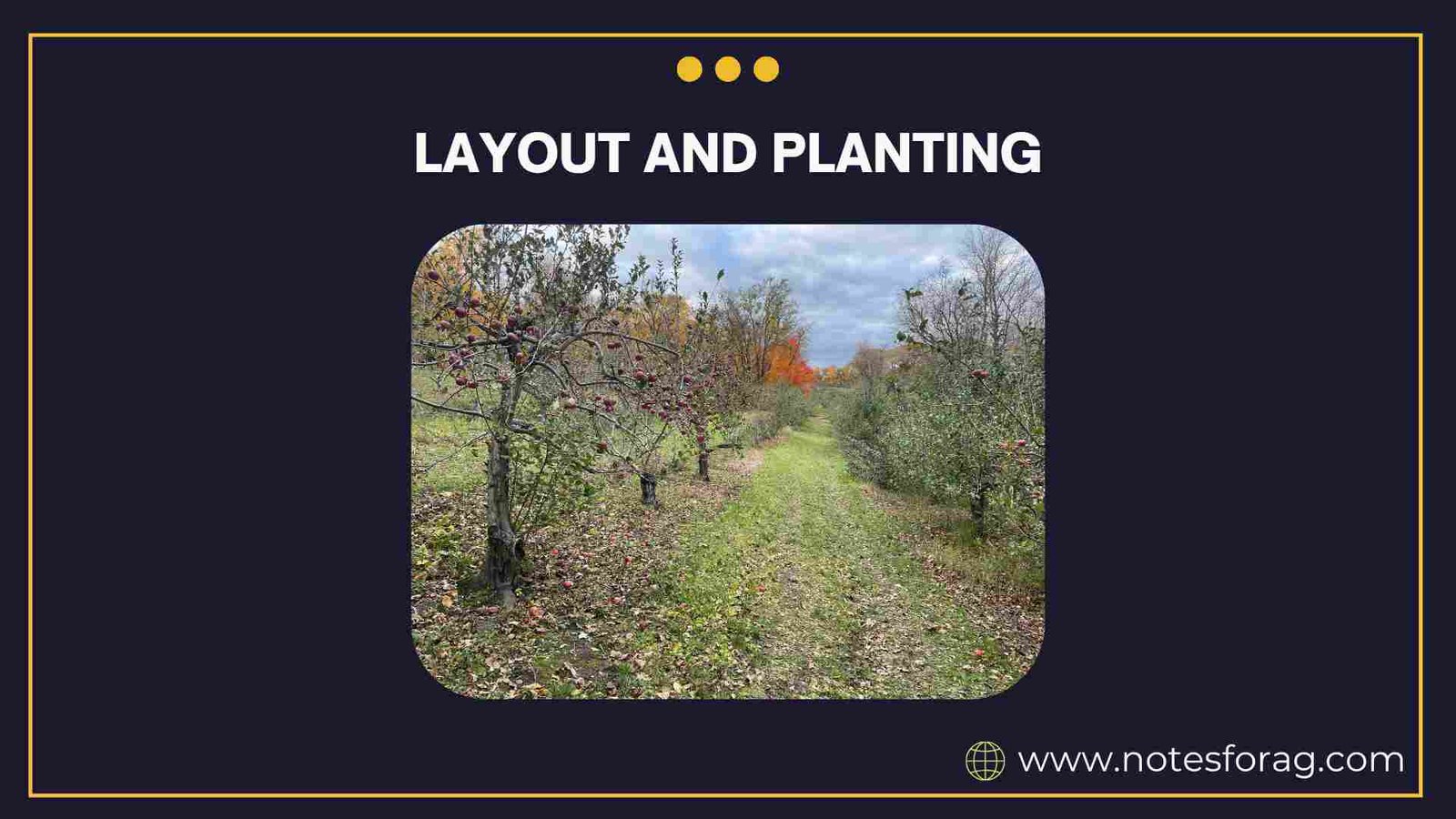1. Introduction

The layout and planting of an orchard play a significant role in determining the productivity, management efficiency, and profitability of fruit production. A well-planned orchard ensures optimal space utilization, sunlight exposure, air circulation, irrigation convenience, and effective pest and disease control. Proper layout also provides ease of mechanization and better accessibility for cultural practices such as pruning, spraying, and harvesting.
Summary of layout and planting of orchard
- Proper orchard layout and planting ensure efficient space use, better crop management, and long-term productivity.
- Factors like soil type, climate, crop variety, planting distance, and planting systems (square, rectangular, contour, etc.) are crucial for orchard success.
- Scientific planning, timely execution, and post-planting care are essential for sustainable orchard growth and high fruit yield.
Table of Contents
2. Site Selection and Preparation
1. Climatic Requirements
Before establishing an orchard, it’s essential to understand the climatic needs of the chosen fruit species. Factors like temperature, rainfall, humidity, frost incidence, and wind patterns must align with the crop requirements for optimal growth and fruiting.
2. Soil Conditions
The ideal soil for an orchard should be deep, fertile, well-drained, and rich in organic matter. A neutral to slightly acidic pH (6.0 to 7.5) is preferable. Before planting, soil testing should be done to assess fertility status and make necessary amendments.
3. Land Preparation
The selected site should be cleared of bushes, weeds, and stones. Ploughing and leveling should follow to ensure proper drainage and ease of movement. If the land is uneven, terracing or contour bunding may be necessary to prevent erosion and water runoff.
3. Orchard Layout Systems
1. Square System

In the square system, trees are planted at the corners of a square, forming rows and columns. This layout is the simplest and allows for easy intercultural operations in both directions.
2. Rectangular System
This system is similar to the square system but the distance between rows is more than the distance between plants within the row. This method facilitates better air circulation and sunlight penetration.
3. Hexagonal System
In this method, trees are planted at the corners of equilateral triangles, creating a hexagonal pattern. It accommodates about 15% more trees than the square system and provides equal spacing on all sides.
4. Quincunx System
This system is a modification of the square system where an additional tree is planted at the center of each square. These central trees are usually filler crops that are removed once the main trees mature.
5. Contour System
This system is used on hilly terrain. Trees are planted along the contour lines to minimize soil erosion and water runoff. Terracing is often done before planting.
4. Spacing in Orchard Planting
1. Factors Affecting Spacing
Spacing depends on the type of fruit tree (vigorous or dwarf), soil fertility, irrigation facilities, and intercultural practices. Proper spacing ensures good root development and canopy growth.
2. Examples of Spacing
- Mango: 10m x 10m
- Guava: 5m x 5m
- Banana: 2.5m x 2.5m
- Citrus: 6m x 6m
5. Digging and Filling of Pits
1. Pit Dimensions
Pits are usually dug 1m x 1m x 1m in size, but the size can vary depending on the tree species and soil condition. Digging should be done at least 2-3 weeks before planting.
2. Pit Filling
Pits are filled with a mixture of topsoil, farmyard manure (FYM), neem cake, and bio-fertilizers. This mixture promotes early establishment and better root development.
6. Planting of Saplings
1. Selection of Healthy Saplings
Only certified, disease-free, and healthy saplings of recommended varieties should be selected. The sapling should have a good root system and a straight, strong stem.
2. Planting Technique
Planting should be done preferably in the evening or during cloudy weather. Saplings are placed in the center of the pit, soil is firmly packed around the roots, and watering is done immediately after planting.
7. Training and Pruning After Planting
1. Importance of Training
Training is given to young trees to develop a strong framework and desired canopy shape. It ensures good light penetration and facilitates cultural operations.
2. Need for Pruning
Pruning helps remove dead, diseased, or weak branches and encourages new growth. Regular pruning improves yield and fruit quality.
8. Irrigation and Mulching
1. Watering Schedule
Newly planted saplings require frequent watering to establish their roots. Once established, irrigation frequency depends on the species, soil type, and weather.
2. Use of Mulching
Applying organic mulch like straw or dry leaves helps retain soil moisture, suppress weeds, and improve soil structure.
9. Intercultural Operations and Intercropping
1. Weed Control
Regular hoeing and manual weeding help maintain cleanliness in the orchard and reduce pest incidence.
2. Intercropping
Legumes, vegetables, or short-duration crops can be grown between young orchard rows. It provides extra income and improves soil fertility.
10. Orchard Maintenance and Record Keeping
1. Regular Monitoring
Periodic observation for pest infestation, disease symptoms, and nutrient deficiencies helps in early intervention and better crop health management.
2. Record Keeping
Maintaining records of planting date, variety, fertilizer application, pest control, and yield data helps in better planning and scientific orchard management.
11. Conclusion
The layout and planting of an orchard are foundational steps in establishing a productive and sustainable fruit cultivation system. A well-designed orchard layout ensures optimum space utilization, ease of cultural operations, efficient irrigation and drainage, better pest and disease management, and long-term profitability. Selecting the appropriate system such as square, rectangular, triangular, hexagonal, quincunx, or contour should depend on factors like land topography, soil type, crop variety, climate, and available resources.
In addition to layout design, successful orchard planting requires scientific planning and execution. Site selection based on soil fertility, pH, drainage, and exposure to sunlight is crucial. The choice of fruit crops and varieties must align with the local agro-climatic conditions to ensure good adaptation and maximum yield potential. Pit preparation with proper dimensions, organic matter enrichment, and pre-planting treatments create favorable conditions for root development.
Planting distance and alignment must be carefully followed to avoid overcrowding, ensure proper sunlight interception, and support healthy canopy development. Seasonal timing of planting, especially during monsoon or early winter, helps in better plant establishment. Special attention to irrigation facilities, windbreaks, fencing, and training systems further enhances the productivity of the orchard.
Moreover, orchard establishment is not a one-time activity; it requires regular monitoring, training, and management from planting to maturity. The long-term health of fruit trees depends on the initial care taken during layout and planting. Farmers and horticulturists must be equipped with scientific knowledge and practical skills to make informed decisions at every step of the process.
To sun up, orchard layout and planting are both art and science. When done properly, they form the backbone of a successful fruit enterprise, contributing significantly to food security, economic upliftment, and sustainable agriculture.
Frequently Asked Questions (FAQs)
When is the best time to plant fruit trees?
The optimal time to plant dormant fruit trees is in early spring or late autumn, giving young trees time to establish roots before active growth begins.
How far apart should I space my fruit trees?
Spacing depends on tree size standard trees need 20–30 ft, semi-dwarfs 12–15 ft, and dwarf varieties about 8–10 ft apart to ensure proper airflow, sunlight, and room for machinery.
What soil conditions are ideal for orchards?
Fruit trees thrive in deep, well-drained loamy soil with a pH between 6.0 and 7.5; soils with poor drainage need raised beds or improved drainage before planting .
Do I need more than one tree for pollination?
Many fruit trees (like apples, pears, and cherries) require at least two different cultivars flowering at the same time for cross-pollination, while some (e.g., figs, peaches) are self-fertile.
Related Articles

